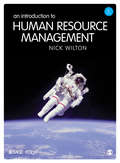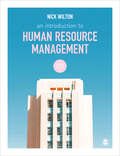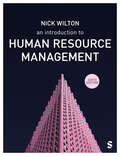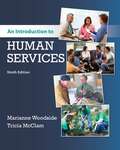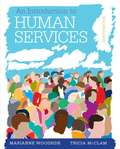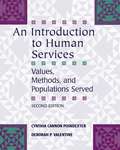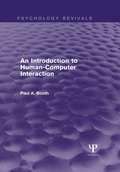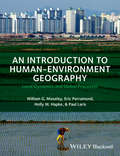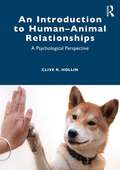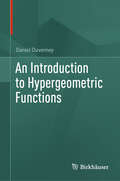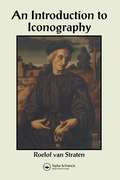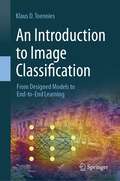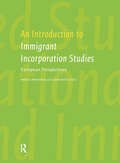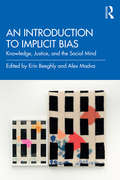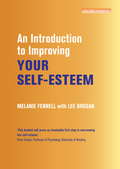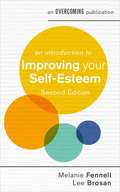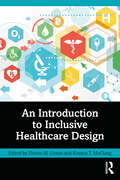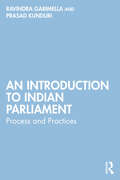- Table View
- List View
An Introduction to Human Resource Management
by Nick WiltonThis exciting new introductory text in human resource management moves beyond a prescriptive approach to provide a holistic overview of the role of HRM in its contemporary context. Acknowledging and reflecting upon key trends in HRM, the labour market and the broader economy, the author offers critical discussion of the theoretical and practical issues surrounding HRM. Includes accessible learning features to help you best explore the material, including: - 'research', 'ethics' and 'international' insight boxes; - chapter summaries and objectives; - self-test questions; - recommended reading; - end of chapter case studies. An accompanying companion website (www. sagepub. co. uk/wilton) provides you with full-text journal articles, extended case studies, weblinks and a glossary. The website also provides an instructor's manual, PowerPoint slides and a multiple-choice test bank for lecturers. This book is essential reading for undergraduate, postgraduate and MBA students, as well as those studying for their CIPD qualifications. Nick Wilton is Senior Lecturer in HRM at Bristol Business School at the University of the West of England. "Well-researched, well-written, and is clearly signposted and structured for the reader. The learning objectives at the outset of every chapter act as a clear guide for each topic explored. Additional references and further reading are also offered to the student seeking deeper knowledge. Case studies, throughout the book, bring the HRM theories to life and demonstrably link these with practice. Wilton’s book is an extremely useful core text for students of HRM and a welcome addition to HRM resources" - Denise Bagley, Principal Lecturer in Human Resource Management, London South Bank University
An Introduction to Human Resource Management
by Nick WiltonReflecting the global nature of the workplace, this is a concise introduction to the world of human resource management that goes beyond a prescriptive, how-to approach and prepares you for the issues and dilemmas you may face in your HR career. Includes new discussions on the impact of Black Lives Matter on HR, the effect of Covid-19 on recruitment and on the mental health of employees, and post-Brexit points-based immigration Boxed features including ‘Ethical Insights’, ‘Research Insights’, and ‘HRM in Practice’ highlight contemporary practices, critical perspectives, and discussions and debates related to each chapter Now features a running case study, where in each chapter you can apply what you’ve learnt to solve a challenge faced by the HR Manager of a hotel Illustrated with real-world case studies and examples from a cross section of industries, such as Netflix, Nike, and Just Eat Comprehensive online resources, including author videos, over 25 additional case studies, access to full journal articles and self-test quizzes. Suitable for anyone studying HRM – as part of an undergraduate or postgraduate degree, or on a specialist program of study.
An Introduction to Human Resource Management
by Nick WiltonReflecting the global nature of the workplace, this is a concise introduction to the world of human resource management that goes beyond a prescriptive, how-to approach and prepares you for the issues and dilemmas you may face in your HR career. Includes new discussions on the impact of Black Lives Matter on HR, the effect of Covid-19 on recruitment and on the mental health of employees, and post-Brexit points-based immigration Boxed features including ‘Ethical Insights’, ‘Research Insights’, and ‘HRM in Practice’ highlight contemporary practices, critical perspectives, and discussions and debates related to each chapter Now features a running case study, where in each chapter you can apply what you’ve learnt to solve a challenge faced by the HR Manager of a hotel Illustrated with real-world case studies and examples from a cross section of industries, such as Netflix, Nike, and Just Eat Comprehensive online resources, including author videos, over 25 additional case studies, access to full journal articles and self-test quizzes. Suitable for anyone studying HRM – as part of an undergraduate or postgraduate degree, or on a specialist program of study.
An Introduction to Human Resource Management
by Nick WiltonGrasp the fundamentals of Human Resource Management with this engaging and accessible text, ideal for undergraduate and postgraduate students. Covering the key aspects of HRM, this bestselling book will prepare you for the strategic decisions and issues you may face in your HR career. This updated 6th edition includes current discussions on topics such as the gig economy, gender equality and AI and is packed with useful learning features, including: · Case studies from a cross-section of global industries, such as Netflix, Uber and Lego · A running case study throughout, allowing you to relate theory to practice as you solve the challenges faced by the HR Manager of a hotel · ‘HRM in Practice’, ‘Ethical Insight’ and ‘Global Insight’ boxes, which look at HRM in a practical context and stimulate critical debate · Self-test questions and a key terms glossary to allow you to check your understanding as you learn. Nick Wilton is Professor of Applied Human Resource Management, and Dean of Oxford Brookes Business School.
An Introduction to Human Resource Management
by Nick WiltonGrasp the fundamentals of Human Resource Management with this engaging and accessible text, ideal for undergraduate and postgraduate students. Covering the key aspects of HRM, this bestselling book will prepare you for the strategic decisions and issues you may face in your HR career. This updated 6th edition includes current discussions on topics such as the gig economy, gender equality and AI and is packed with useful learning features, including: · Case studies from a cross-section of global industries, such as Netflix, Uber and Lego · A running case study throughout, allowing you to relate theory to practice as you solve the challenges faced by the HR Manager of a hotel · ‘HRM in Practice’, ‘Ethical Insight’ and ‘Global Insight’ boxes, which look at HRM in a practical context and stimulate critical debate · Self-test questions and a key terms glossary to allow you to check your understanding as you learn. Nick Wilton is Professor of Applied Human Resource Management, and Dean of Oxford Brookes Business School.
An Introduction to Human Services
by Marianne Woodside Tricia McClamInterested in a practical introduction to the human service profession? If the answer's yes, then this book is for you. <p><p> Drawing on their extensive experience, the authors define human services, review the historical development of advocacy, and examine service delivery models and processes. They thoroughly explore the current state of this rapidly evolving profession as well as the essential skills you need to succeed within it. <p><p> You'll gain a solid grounding in such fundamental concepts as serving the whole person, using an interdisciplinary approach, interacting with helper and client, preparing generalists, understanding multicultural influences, and empowering clients. Detailed case studies give you frontline perspectives -- and prepare you to effectively address issues you're likely to encounter as a helping professional.
An Introduction to Human Services (Eighth Edition)
by Marianne Woodside Tricia McclamOffers an introduction to the human services profession. Based on the authors' extensive experience as practitioners, educators, and researchers, this text defines human services, reviews the historical development of the field, provides an overview of the profession, and emphasizes the skills needed to succeed as a human services practitioner
An Introduction to Human Services: Policy and Practice
by Barbara Schram Betty Mandell Paul Dann Lynn PetersonComplete, up-to-date coverage of social welfare programs and policies with special coverage of how history, politics, and the economy shape these programs This text puts the field of human services into a historical context, provides insights into the social welfare field, and gives concrete examples of how primary intervention strategies are put into daily practice in human service agencies. It presents the many options offered in the field of human services and discusses the stresses that a human service worker will face in day-to-day work, with practical suggestions for avoiding burnout. The text compares the U.S. social welfare systems to systems in other countries, and uses a strong multicultural and social systems approach that distinguishes it from other texts. Teaching & Learning Experience Personalize Learning — MyHelpingLab delivers proven results in helping students succeed, provides engaging experiences that personalize learning, and comes from a trusted partner with educational expertise and a deep commitment to helping students and instructors achieve their goals. Engage Students — Outstanding pedagogy, including examples, cases, anecdotes, and interviews, keeps students interested. Explore Current Issues — Contemporary issues are incorporated throughout the text to provide students with the most up-to-date coverage; topics include: cyberbullying, immigration, and health care reform. Support Instructors — An Instructor's Manual and Test Bank, Computerized Test Bank (MyTest), MyHelpingLab with Pearson eText, and PowerPoint presentations, and BlackBoard and WebCT Test Item File provide instructors with additional support. Note: MyHelpingLab does not come automatically packaged with this text. To purchase MyHelpingLab, please visit: www.myhelpinglab.com or you can purchase a valuepack of the text + MyHelpingLab (at no additional cost). VP: 0205060560
An Introduction to Human Services: Values, Methods, and Populations Served (2nd edition)
by Cynthia Cannon Poindexter Deborah P. ValentineThis concise, useful guide introduces the necessary basic skills students need to effectively support and guide persons who need assistance from social services systems.
An Introduction to Human-Computer Interaction (Psychology Revivals)
by Paul BoothOriginally published in 1989 this title provided a comprehensive and authoritative introduction to the burgeoning discipline of human-computer interaction for students, academics, and those from industry who wished to know more about the subject. Assuming very little knowledge, the book provides an overview of the diverse research areas that were at the time only gradually building into a coherent and well-structured field. It aims to explain the underlying causes of the cognitive, social and organizational problems typically encountered when computer systems are introduced. It is clear and concise, whilst avoiding the oversimplification of important issues and ideas.
An Introduction to Human-Environment Geography
by William G. Moseley Holly M. Hapke Paul Laris Eric PerramondThis introductory level text explores various theoretical approaches to human-environment geography, demonstrating how local dynamics and global processes influence how we interact with our environments.Introduces students to fundamental concepts in environmental geography and scienceExplores the core theoretical traditions within the field, along with major thematic issues such as population, food and agriculture, and water resourcesOffers an engaging and unique view of the spatial relationships between humans and their environment across geographical locations around the worldIncludes a variety of real-world policy questions and emphasizes geography's strong tradition of field work by featuring prominent nature-society geographers in guest field notes
An Introduction to Humanitarian Action (Routledge Humanitarian Studies)
by Kristina Roepstorff Katrin RadtkeThis important new textbook provides a concise and practice-oriented introduction to the workings of the humanitarian sector and the key contemporary debates surrounding it.The number of people around the world in need of humanitarian action and protection is at its highest figure in decades; yet at the same time, the humanitarian system is facing numerous problems and undergoing fundamental reforms. This book invites us to tackle these challenges head on, addressing the increasing complexity of humanitarian crises and the implications for humanitarian principles and standards as well as the management of humanitarian projects. Expansive in scope, the book covers: The sector’s historical foundations and the need to decolonise The main types of crises and sectors of humanitarian response State and non-state actors and institutions The key rules, norms, and project management approaches Key trends and challenges, including access, innovation, and anticipation The book also covers important debates on localisation, inclusive programming, and the decolonisation of the humanitarian system. This exciting new textbook will be an important read for students looking for a comprehensive introduction, as well as for practitioners wanting to stimulate critical thinking and enhance their practical skills.
An Introduction to Human–Animal Relationships: A Psychological Perspective
by Clive R. HollinAn Introduction to Human–Animal Relationships is a comprehensive introduction to the field of human–animal interaction from a psychological perspective across a wide range of themes. Hollin examines the topic of the relationships between humans and animals as seen in owning a companion animal alongside more indirect relationships such as our approaches to eating meat. The core issues under discussion include the moral and ethical issues raised in using animals for entertainment, in therapy, to keep us safe, and in sports such as horse racing. The justifications for hunting and killing animals as sport and using animals in scientific experimentation are considered. The closing chapter looks to the future and considers how conservation and climate change may influence human–animal relationships. This key text brings an important perspective to the field of human–animal studies and will be useful to students and scholars in the fields of psychology, sociology, animal welfare, anthrozoology, veterinary science, and zoology.
An Introduction to Hypergeometric Functions
by Daniel DuverneyThis textbook provides an elementary introduction to hypergeometric functions, which generalize the usual elementary functions. It includes plenty of solved exercises and it is appropriate for a wide audience, starting from undergraduate students in mathematics, physics and engineering. Since the presented functions are limited to hypergeometric functions of a real variable, the only prerequisites are the basics of real analysis.
An Introduction to Iconography: Symbols, Allusions and Meaning in the Visual Arts (Documenting The Image Ser. #Vol. 1)
by Roelof van StratenAvailable for the first time in English, An Introduction to Iconography explains the ways that artists use references and allusions to create meaning. The book presents the historical, theoretical, and practical aspects of iconography and ICONCLASS, the comprehensive iconographical indexing system developed by Henri van de Waal. It gives particular emphasis to the history of iconography, personification, allegory, and symbols, and the literary sources that inform iconographic readings, and includes annotated bibliographies of books and journal articles from around the world that are associated with iconographic research.The author of numerous articles and a four-volume reference work on Italian prints, Roelof van Straten is currently working on an iconographic index covering the prints of Goltzius and his school.
An Introduction to Image Classification: From Designed Models to End-to-End Learning
by Klaus D. ToenniesImage classification is a critical component in computer vision tasks and has numerous applications. Traditional methods for image classification involve feature extraction and classification in feature space. Current state-of-the-art methods utilize end-to-end learning with deep neural networks, where feature extraction and classification are integrated into the model. Understanding traditional image classification is important because many of its design concepts directly correspond to components of a neural network. This knowledge can help demystify the behavior of these networks, which may seem opaque at first sight. The book starts from introducing methods for model-driven feature extraction and classification, including basic computer vision techniques for extracting high-level semantics from images. A brief overview of probabilistic classification with generative and discriminative classifiers is then provided. Next, neural networks are presented as a means to learn a classification model directly from labeled sample images, with individual components of the network discussed. The relationships between network components and those of a traditional designed model are explored, and different concepts for regularizing model training are explained. Finally, various methods for analyzing what a network has learned are covered in the closing section of the book. The topic of image classification is presented as a thoroughly curated sequence of steps that gradually increase understanding of the working of a fully trainable classifier. Practical exercises in Python/Keras/Tensorflow have been designed to allow for experimental exploration of these concepts. In each chapter, suitable functions from Python modules are briefly introduced to provide students with the necessary tools to conduct these experiments.
An Introduction to Immigrant Incorporation Studies: European Perspectives (IMISCOE Textbooks)
by Jan Rath Marco MartinielloFocusing mainly on the European experience including Eastern Europe, this important volume offers an advanced introduction to immigrant incorporation studies from a historical, empirical and theoretical perspective. Beyond incorporation theories, renowned scholars in the field explore incorporation in action in different fields, policy issues and normative dimensions.
An Introduction to Implicit Bias: Knowledge, Justice, and the Social Mind
by Erin Beeghly Alex MadvaWritten by a diverse range of scholars, this accessible introductory volume asks: What is implicit bias? How does implicit bias compromise our knowledge of others and social reality? How does implicit bias affect us, as individuals and participants in larger social and political institutions, and what can we do to combat biases? An interdisciplinary enterprise, the volume brings together the philosophical perspective of the humanities with the perspective of the social sciences to develop rich lines of inquiry. Its twelve chapters are written in a non-technical style, using relatable examples that help readers understand what implicit bias is, its significance, and the controversies surrounding it. Each chapter includes discussion questions and additional annotated reading suggestions, and a companion webpage contains teaching resources. The volume is an invaluable resource for students—and researchers—seeking to understand criticisms surrounding implicit bias, as well as how one might answer them by adopting a more nuanced understanding of bias and its role in maintaining social injustice.
An Introduction to Improving Your Self-Esteem
by Leonora Brosan Dr Melanie FennellA new addition to the popular Introduction to Coping with series of CBT-based self-help booklets. Written by the author of the bestselling Overcoming Low Self-Esteem and the popular self-help title Overcoming Stress, An Introduction to Coping with Low Self-Esteem offers expert advice to anyone struggling with self-confidence. Includes helpful information on what causes and maintains low self-esteem and proven CBT strategies to beat it.
An Introduction to Improving Your Self-Esteem, 2nd Edition
by Melanie Fennell Leonora BrosanLow self-esteem can impact on many areas of your life such as your relationships, work life and general wellbeing. This invaluable self-help guide will help you to understand what has led to your poor self-esteem, what keeps it going and how to improve your self-image, gaining a more balanced and positive view of yourself. This self-help guide is based on clinically proven cognitive behavioural therapy (CBT) techniques to help you improve your confidence. You will learn:- How low self-esteem develops- How to challenge negative predictions- How to improve self-acceptance
An Introduction to Improving Your Self-Esteem, 2nd Edition (An Introduction to Coping series)
by Leonora Brosan Dr Melanie FennellLow self-esteem can impact on many areas of your life such as your relationships, work life and general wellbeing. This invaluable self-help guide will help you to understand what has led to your poor self-esteem, what keeps it going and how to improve your self-image, gaining a more balanced and positive view of yourself. This self-help guide is based on clinically proven cognitive behavioural therapy (CBT) techniques to help you improve your confidence. You will learn:- How low self-esteem develops- How to challenge negative predictions- How to improve self-acceptance
An Introduction to Improving Your Self-Esteem, 2nd Edition (Overcoming Ser.)
by Melanie Fennell Leonora BrosanOvercoming app now available.This is a new addition to the popular Introduction to Coping with series of CBT-based self-help booklets. Written by the author of the bestselling Overcoming Low Self-Esteem and the popular self-help title Overcoming Stress, An Introduction to Coping with Low Self-Esteem offers expert advice to anyone struggling with self-confidence. Includes helpful information on what causes and maintains low self-esteem and proven CBT strategies to beat it.
An Introduction to Inclusive Healthcare Design
by Denise M. Linton Kiwana T. McClungAn Introduction to Inclusive Healthcare Design is a comprehensive guide to the design and facilitation of safe, healthy, equitable, and inclusive healthcare settings across a variety of scales. The book informs healthcare professionals, healthcare administrators, planners, designers in the healthcare sector, design students, and faculty about best practices and considerations for inclusive design.The primary theme for the book is design for all – considering the design of healthcare spaces through the lenses of inclusivity and social equity. Part 1 presents the reader with an overview of the variety of locations and types of healthcare settings. Part 2 provides a comprehensive overview of the principles of equitable and inclusive healthcare design and considers how these principles can be applied to the range of settings laid out in Part 1. The authors consider inclusivity-supportive infrastructure in primary and ancillary spaces within healthcare settings. Part 3 envisions the future of inclusive healthcare design, considering the integration of virtual reality and artificial intelligence, as well as addressing the ever more relevant issue of healthcare provision in settings at risk of natural disasters.
An Introduction to Indian Parliament: Process and Practices
by Ravindra Garimella Prasad KunduriThis book presents a comprehensive introduction to Indian Parliament encapsulating the process and practices since its inception. It discusses crucial themes including the emergence of Parliament and its contours; constitutional provisions and rules of procedure; role of President as a part of the Parliament; parliamentary devices; privileges, norms of standards and etiquettes; legislation process and budget; accountability to Parliament and outreach; relationship with judiciary and media; Parliament and international institutions; and the role of Parliament on issues related to gender, minorities and reservation in India.This book will be an essential read for students of political science, Indian politics, and political institutions, along with journalists, political analysts, professionals in Indian think tanks, and Indian politicians.
An Introduction to Indian Philosophy
by Roy W. PerrettThis wide-ranging introduction to classical Indian philosophy is philosophically rigorous without being too technical for beginners. Through detailed explorations of the full range of Indian philosophical concerns, including some metaphilosophical issues, it provides readers with non-Western perspectives on central areas of philosophy, including epistemology, logic, metaphysics, ethics, philosophy of language, and philosophy of religion. Chapters are structured thematically, with each including suggestions for further reading. This provides readers with an informed overview whilst enabling them to focus on particular topics if needed. Translated Sanskrit texts are accompanied by authorial explanations and contextualisations, giving the reader an understanding of the argumentative context and philosophical style of Indian texts. A detailed glossary and a guide to Sanskrit pronunciation equip readers with the tools needed for reading and understanding Sanskrit terms and names. The book will be an essential resource for both beginners and advanced students of philosophy and Asian studies.
